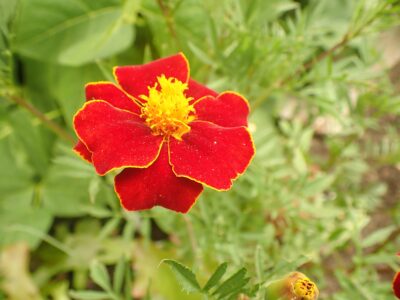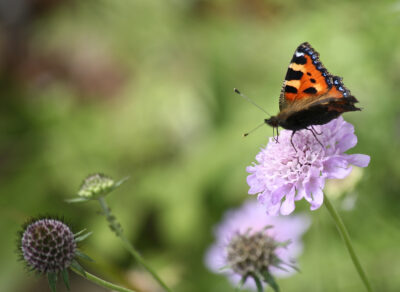
It’s time to get sowing and growing, because spring is in the air. In the last few days, I’ve had a cup of tea in the garden, my face warmed by the sun for the first time this year. My ginger tomcat Frank has been rolling about, with his legs in the air, and this is Frank’s way of saying – it’s going to be really warm soon. Let’s hope Frank’s right!
It’s important to catch the moment when spring roars into life, for seeds germinate willingly in that window of opportunity. A word of warning. Don’t be fooled by those clear, early spring days when temperatures in your greenhouse climb well above 20C. For, if the sky’s clear, a frosty night will surely follow on. Those conditions will mean a 20C difference within 24 hours and that difference will stop germination. Wait for warmer nights, if possible, and then your seeds will romp away.
March is a good time to start off seeds, if you’re dealing with hardy plants. Packeted seeds with the letters HP, for hardy perennial, HA for hardy annual, or HB for hardy biennial can be sown now. Half-hardy annuals or HHA, like zinnias and petunias, need warmer temperatures so April is soon enough for these. They can’t go out into the garden until early June, because they are vulnerable to frosts.
My garden is all about helping pollinating insects, because I love to watch them going from flower to flower. Luckily, the most insect-friendly flowers of all are hardy annuals and hardy biennials, because they both rely on setting seeds
to survive. Hardy annuals (HA) live for one year only. Hardy biennials live for two years: they generally form a rosette in the first year and flower in the second. Sweet Williams, most seed-raised wallflowers, hollyhocks, some foxgloves and many verbascums, are hardy biennials. Many biennials provide good winter foliage. Annual and biennial seeds are willing to germinate and sometimes seedlings can appear within days and that’s always an exciting moment.

Three very easy, insect-friendly hardy annuals, ones which go on flowering into autumn, are African marigold, scabious and cosmos. They are all adored by pollinating insects and they all provide flower over many months, often going on until November.
I have a simple system for sowing these three, one that saves pricking out individual seedlings. This saves time and back ache, for few things are as muscle-wrenching as handling one seedling at a time. Firstly, arm yourself with some decent seed-sowing compost (such as Dalefoot’s) or some peat-free John Innes no 1. Melcourt does a Sylvamix seeds and cuttings compost. These are low in nutrients fine in texture. If the compost contains lumps, it inhibits germination. If it smells – don’t use it for seeds. Melcourt, made from wood fibre, have begun date stamping their compost with a best before date. Never buy compost that been stored outside. It deteriorates.
Use large seed trays and place one 6 x 4 modular tray inside each tray. This will give you 24 modules. Water the trays well and allow to drain. Cosmos, scabious and African marigold seeds are large enough to handle. Use 2 – 3 seeds in each module and place your trays in a greenhouse if possible. Within four to five weeks the roots will have filled the module. These trays will last for many years. Plant you ‘plugs’ out in early May. You can also use fibre trays.

Pesetaweg 35
2153 PJ Nieuw Vennep.
There are so many different cosmos varieties on offer, but pink and white varieties are the ones to choose, because they are derived from C. bipinnatus. They form bushy plants with ferny foliage, although heights can vary. Deadhead the spent flowers to keep them going. If you want to collect your own seeds, leave a couple of plants alone and harvest the seeds when they feel hard to the touch. Cosmos go well with roses or mixed herbaceous plants.
Chiltern Seeds – www.chilternseeds.co.uk sell a good range and they always offer good value for money. Good single pinks include the dainty and slightly shorter ‘Daydream’ and the medium-height deep-pink ‘Gazebo Red’. (Premier Seeds Direct sell the latter far more cheaply than others).
Modern breeding had added more petals, although I find that fully double cosmos flowers can be heavy headed. I prefer ‘Velouette’, a ragged pink and white, and ‘Picotee’ a white with plenty of pink on the petals. The old pure-white single, ‘Purity’, is still worth growing but bear in mind that clear-white is harder to place in a sunny border. Give this one light shade.
African marigolds are loved by bees and hoverflies and I use them close to runner beans and other vegetables. Last year they were still in flower in December. Go for taller single-flowered forms and ignore the doubles, because they offer nothing to pollinators. The taller singles look wonderful popping up through lettuces etc. Favourites include the yellow-edged, deep-orange ‘Burning Embers’ and the velvety red ‘Cinnabar’. Seeds can be collected from both.
Hoverflies adore anything orange or yellow and they are part of the gardeners’ trouble-shooting squad. They lay their eggs close to colonies of aphids and their maggot-like larvae eat the aphids. Beauty, plus pest control, you can’t beat it. African marigolds make good slug decoy plants, because they attract molluscs and hopefully keep them away from the tips of your runner beans. Frisk them at dusk, armed with a torch, stout footwear and gloves.

The prize for the most insect-friendly flower is awarded ( by me) to the scabious and there are annual and perennial forms. It’s not unusual to find a bee and a butterfly on the same small pincushion. Butterflies always go for concentrated nectar and they’ll often head for a scabious. The seeds are also large enough to handle, so you can use the same modular-tray method.
Good varieties include the deep-pink-red Scabiosa atropurpurea ‘Beaujolais Bonnets’ and the pale-pink ‘Salmon Queen’. (both Chiltern Seeds) ‘Salmon Queen’ has a tight middle surrounded by a ruff of frilly petals. Scabious cut well, but some cut-flower varieties are alittle too tall. Chiltern Seeds also have a purple, ‘Burgundy Beau’ and ‘Merlot Red’.
The best thing about seed sowing in your Hartley greenhouse is the warmth. You don’t feel the nip in the air, or the wind when you’ve entered your dream space!



